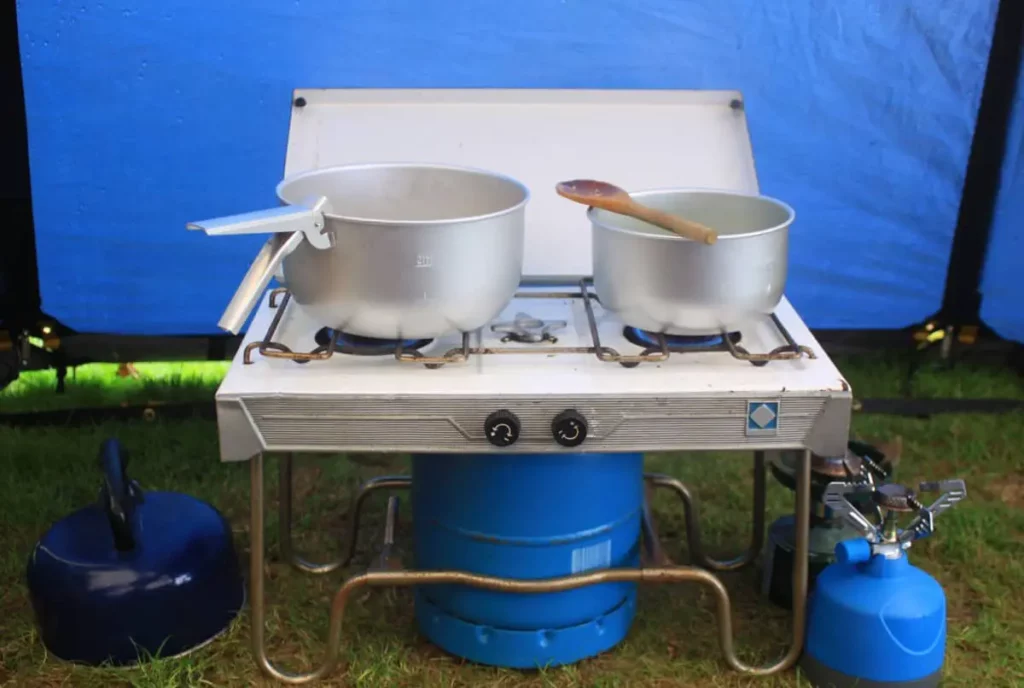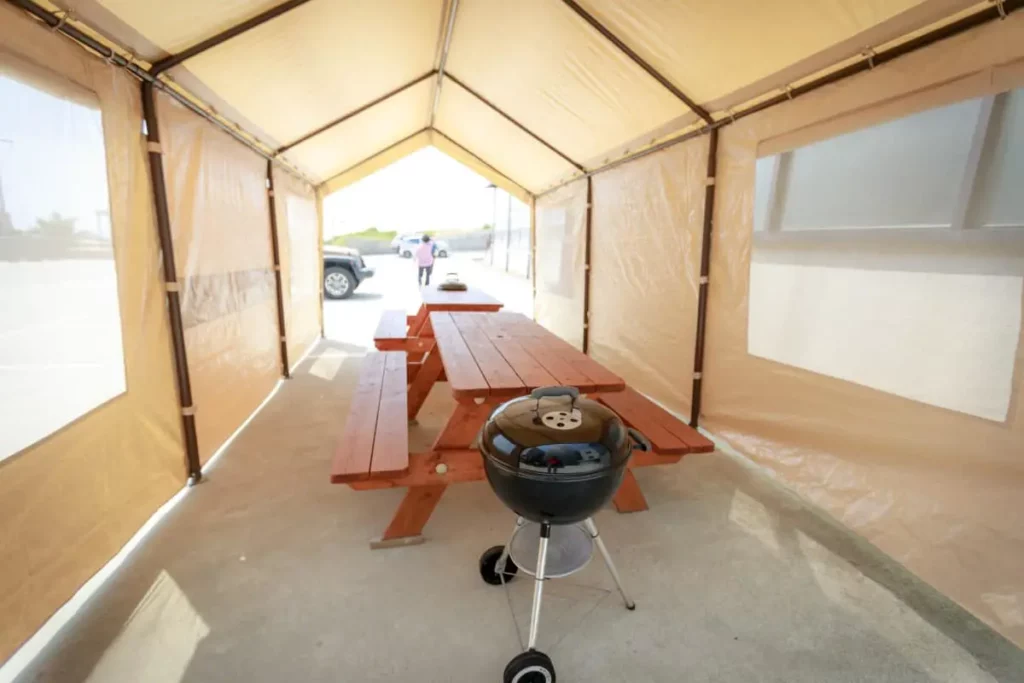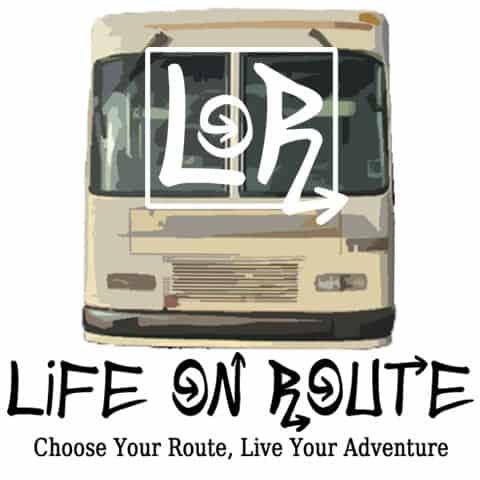This post contains affiliate links.
Using a Camp stove indoors is a question about safety and planning. They are not designed or intended to be used indoors but in some situations it may be necessary to do so. There are risks to burning camp stove fuel indoors so follow these guidelines to remain safe.
Can you use a camp stove indoors? You can use a camp stove indoor but need to be very careful. Here are some steps to help you do it safely.
- Provide good airflow
- Have a fresh air supply
- Use a carbon monoxide detector
- Cook on a level surface
- Clear the area of flammables
- Have an exit plan

In this article, we’re going to talk about everything you need to know before using a camp stove indoors.
Table of Contents
Tips For Ensuring Safe Use of a Camp Stove Indoors
Provide Good Airflow
Using camp stoves indoors isn’t generally recommended. However, there are some things you can do to ensure safety. One of which is by ensuring proper airflow. You need to have additional airflow in the area where you are going to cook using the camp stove.
This way, you’re able to get rid of the toxic fumes that are emitted from the camp stove in your area. You can do this by using an exhaust fan or an ordinary fan along with a fresh air supply from an open window or door.
You need to get rid of the carbon monoxide fumes as these are toxic to the body. Inhaling carbon monoxide for prolonged durations harms your body and can cause nausea, can render you unconscious, or worse, cause death.
Create Adequate Fresh Air Supply
Not only do you need an adequate air supply to remove the fumes produced from using a camp stove indoors but you also need it to supply oxygen.
Flames consume oxygen as they burn so having an open window or door to replenish the supply of oxygen in your space is essential. Otherwise you’ll be fighting over oxygen with your camp stove.
Use a Carbon Monoxide Detector
Use a carbon monoxide detector to protect from the buildup of carbon monoxide levels in your area. This is important because too much carbon monoxide (CO) can harm your body and can knock you unconscious if you’re exposed to it for long periods of time.
The natural CO air concentration is 0.2 PPM. Anything beyond that is harmful. However, using a CO detector notifies you by emitting a loud alarm if CO levels are high enough to be harmful.
One good example is the Kidde Nighthawk Alarm available on Amazon. It’s a simple to use CO detector that features a loud 85-decibel alarm sound if carbon monoxide levels around your area reach dangerous levels.
It plugs directly into an outlet so there is no wiring required.
Carbon monoxide naturally rises to the top of a room but overall fills the room evenly. Your CO detector should be between waist and nose height on the wall which is breathing space whether sitting or standing.
- Easy Installation - simply plug-in to a standard, 120V outlet in your home
- 9-volt battery backup provides protection during a power outage
- Digital LED display shows the level of carbon monoxide the CO alarm is sensing
Have An Exit Strategy
Before lighting your camp stove inside a building or structure you should plan ahead to reduce damage and injury. Always use your stove near an open window or door but never block your escape route. You should always have a secondary exit to ensure an easy escape should something go wrong.
Make sure that everybody in the space is aware of the exit routes and the location of the fire extinguisher and emergency contact phone numbers.
Cook On A Level Surface
Make sure that your area is safe. Do this by placing the camp stove on a level table or countertop elevated off the ground to prevent it from being kicked or knocked over.
If your stove has its own stand that raises it off the floor make sure it is on level ground to prevent it from tipping over accidentally. Before you light the stove test it for stability and if it wobbles shim a corner until it is stable or move it to a more level location.
Clear The Area Of Flammables

There should be no other objects near your stove that can accidentally light on fire or melt from the heat. Remove any flammable materials around your cooking area, such as your books, plants, etc. to reduce the chances of combustion.
Control Your Flames
Don’t use more stoves or burners than you need to. Using a camp stove sized to your cooking is recommended because it will reduce the amount of wasted heat and emit a lower amount of harmful fumes.
A smaller stove will usually consume less fuel and create fewer fumes depending on the fuel type and how efficient it is burning. A smaller flame will also burn less oxygen from the room.
Clean And Inspect Your Stove
Regular cleaning and inspection will help make sure your stove is burning efficiently and not leaking fuel. Make sure there is no flammable residue on the burning element from past usage.
Here’s a good resource about cleaning your camping stove
Cook Fast
Don’t cook for long durations especially if you’re using a camp stove that uses canister fuel as these are pressurized gases that can cause harmful effects.
The recommended cooking time for using camp stoves indoors is around 15 to 20 minutes maximum. You want to decrease time as much as possible to minimize the buildup of carbon monoxide indoors.
Plan ahead to choose meals that can be easily cooked and don’t require long cooking times. And make sure to turn off the camp stove after using it.
But if you really need to cook a lot of meals, then giving your stove a rest for about 15 minutes between dishes will allow time to clear out most of the carbon monoxide and replenish the oxygen.
As long as you allow enough airflow and ventilation to remove the fumes and gasses from your indoor space.
Dangers of Using A Camp Stove Indoors
Fire
One of the biggest safety issues related to using a camp stove indoors is the risk of fire. This is especially true with stoves that use canister fuels as these are pressurized and if not handled with care can explode and burst in flames.
The risk of fire spreading is also high knowing that it’s indoors and the flames can spread to almost anything. Thus, it’s also recommended that you have a fire extinguisher at home like this one available from Amazon. Keep it nearby your camp stove while cooking so you can put out any flames if a fire starts.
- First Alert's HOME1 FE1A10GR Fire Extinguisher is UL rated 1-A: 10-B:C; it features durable all-metal construction with a commercial-grade...
- Multipurpose fire extinguisher fights wood, paper, trash, plastics, gasoline, oil, and electrical-equipment fires
- First Alert’s Rechargeable Fire Extinguisher can be recharged by a certified professional after use, allowing for reuse.
Carbon Monoxide Poisoning
Camp stoves are fueled by wood, canister fuels and liquid fuels, all of which emit fumes like carbon monoxide. This is harmful to the body because it displaces your blood’s oxygen and alters its natural movement in your body.
This deprives your vital organs such as your brain and heart of oxygen. This can cause you to lose consciousness when exposed for periods of time, sometimes, even as fast as just a few minutes.
What To Do If A Fire Starts
If ever fire starts, your main focus should be to turn off the camp stove. You might be compelled to immediately get water and throw it directly onto the flames but that may not always be a good solution.
This can even make the flames bigger because water contains oxygen and oxygen can increase the size of flames. If you’re using your camp stove as a deep fryer or have hot cooking oil in it water will only spread the fire out causing it to get worse.
Thus, you need to turn off the source first, which is the camp stove fuel supply. If you can still safely touch the gas canister without burning yourself, then do it. But if it’s already too late and the fire is too big, then just rush everybody outside and call the fire department.
Meanwhile, if you happen to inhale too much carbon monoxide fumes and you start to feel dizzy, then immediately stop cooking. Turn off your camp stove and immediately leave the house. Head outdoors to your garden or an area with fresh air.
Most Common Places To Use Camp Stoves Indoors
Tents
Cooking using a camp stove inside your tent is possible, but very risky. The chances of your tent catching fire and you inhaling lots of carbon monoxide (CO) also becomes higher.
We don’t recommend you cook inside your tent because the fabric that your tent is made of can easily catch fire causing serious injury. But if you’d really want to push through, then you can try opening your tent’s flap entrance or windows.
This leaves you with lots of ventilation and an exit path in case something bad happens. Another concern you should take note of is cooking in bear country or other areas with aggressive wildlife.
Bears and other wildlife have a very strong sense of smell, They will be attracted to your food even if they are miles away. For this reason it is always advisable to keep your cooking area away from your sleeping area and keep your food elevated out of reach when stored.
Garage
Garages are a safer place to use a camp stove indoors because they are able to be opened up and create an area where fresh air can freely flow. Due to the improved ventilation in a garage the carbon monoxide and smoke fumes from the stove can leave the area much easier.
If you want to use your camp stove in your house, then as much as possible, try to use it in the garage. Just make sure there are no flammable objects near your cooking area.
Garages tend to be filled with many different types of fuels, paints and other flammable chemicals so stay aware of the location of your stove. Move it as close to an open door or window as possible and away from flammable hazards.
Shed
Sheds are also a better alternative than using camp stoves inside your home. There’s typically good ventilation, fresh air, and most likely, there are fewer flammable objects. Using a stove in a shed can help to block the wind and the heat from the stove and provide a source of warmth for the space.
Sheds are not attached to a home either so if a fire did occur there is less risk of damage or destruction to your home than if you were to cook in a covered porch or attached garage.
Can You Use a Camping Stove Indoors?
Yes, you can use a camping or backpacking stove indoors if you’d want to cook food or boil water. This goes for using alcohol, butane, white gas and propane stoves but avoid using gasoline, kerosene, or diesel as a fuel source indoors. There’s a certain level of risk involved so take the topics covered in this article into consideration before deciding.
Not only is there risk to your house burning, but you also run the risk of inhaling toxic fumes and potentially poisoning yourself especially if you’re in a closed and small area.
To avoid this and lessen the risk, you must ensure you have sufficient ventilation so that the CO fumes can escape. Also clean up the area and make sure there are no flammable objects near your camp stove. Use a CO detector when possible so you’ll know if the CO levels are high, and keep an extinguisher nearby.



